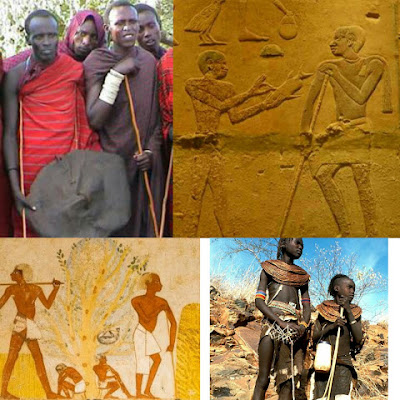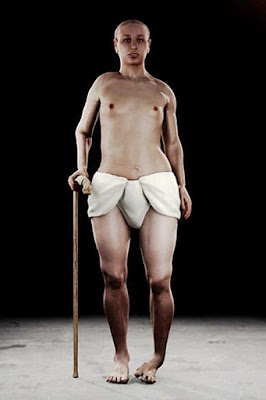I am debunking the absurd claims by Western "Egyptologists" published in Western media as fact that Pharaoh Tutankhamen was crippled which is the reason why he walked with a stick. This claim is anachronistic at best. A pseudo historical claim that completely ignores all the evidence left behind by the original Ancient Egyptians themselves concerning how the boy king looked in real life.
Articles such as this:
http://www.dailymail.co.uk/sciencetech/article-2799418/king-tut-girlish-hips-club-foot-
buck-teeth-according-virtual-autopsy.html
I quote
"With strong features cast in burnished gold, Tutankhamen's burial mask projects an image of majestic beauty and royal power. But in the flesh, king Tut had buckteeth, a clubfoot and girlish hips, according to the most detailed examination ever of the ancient Egyptian Pharaoh's remains. And rather than being a boy king with a love of chariot racing, Tut relied on walking sticks to get around during his rule in the 14th century BC, researcher said."
The researchers who conducted this study are so wrong. I suspect that the main objective for this study was to explain to Europeans and Americans why a perfectly healthy youthful young boy like king Tut can be portrayed in Ancient Egyptian Tomb paintings and sculptures walking around with a stick. Do not believe the lies of this erroneous article because king Tut was not a cripple. Instead of looking deep into the source of ancient Egyptian culture and religion, which is AFRICA. They pass off this false information to the public as though it were fact. Those walking/fighting sticks portrayed in ancient Egyptian tomb paintings and sculptures being held by Egyptians are known throughout the African great lakes region as FIMBO.
A Fimbo is used as a status symbol or a gentleman's accessories for those who belong in a herding tribe or a warrior caste that own cattle. Fimbos can be carried by young warriors (Morani), elders, women, and even children. King Tut holding a Fimbo symbolizes him being a warrior just like the other Thutmosid Pharaohs.
First, there are two types of Fimbos;
1.) GREWIA FIMBOS
The light colored sticks are cut from straight branches of the Grewia spp (Estert). These fimbos vary greatly in thickness and weight and the user will cut a fimbo according to his taste and level of strength. These fimbos are firstly cut and then burned or "roasted" over an open fire. This serves to separate the bark from the wood and to dry the wood without cracking occurring. While the wood is hot and thus pliable the fimbo is straightened by bending it straight. The process is finished after the fimbo has cooled down and straightened. These fimbos are also used as walking sticks by all ages and for cattle herding.
2.)ACACIA MELLIFERA AND EBONY FIMBOS
The dark colored fimbos are cut from a straight Acacia Mellifera log. The lighter sap wood is removed until the dark core wood is reached. One log usually produces two to three fimbos. These fimbos are then finished with a short sword and eventually sanded down using broken glass. When the fimbo is done, either cow or goat fat is applied to oil the wood.
The significance of staffs both symbolically and in actual use is just another one of the countless pan-African traits of ancient Egyptian culture.
Staffs were emblems of authority in Kemet which is why hieroglyphs for offices of leadership or authority either shows a man holding a staff or seated on a throne. These staffs likely originated among pastoral activities or even people wandering the bush areas with staffs for protection. There were different types of staffs symbolizing different forms of authority.
Staffs were emblems of authority in Kemet which is why hieroglyphs for offices of leadership or authority either shows a man holding a staff or seated on a throne. These staffs likely originated among pastoral activities or even people wandering the bush areas with staffs for protection. There were different types of staffs symbolizing different forms of authority.
The staffs with the rounded blunt heads were called ames staffs and were originally used as weapons but eventually became symbols of courage and leadership.
Perhaps the most famous staff was the crook or heka staff.
The heka was a shepherd's staff used in herding flocks and was a symbol of leadership.
There is another staff called a mekes which has a nodule in the middle and was used to perry in fighting, though I'm unable to find any pictures of this staff. Staffs are also known throughout the great lakes region as BAKORA.
There was no way that a cripple would have been able to rule any African nation during ancient times or even become king. One of his cousins or brothers who were in better condition and health would have been made king instead of him. Even today in modern Africa it is difficult for a cripple to become president. Ancient Egyptian culture and religion was very similar to modern African culture and religion south of the Sahara and great lakes region including other regions of Africa.
In ancient Egypt the Egyptians held a ritual jubilee called Heb-Sed for kings to display their prowess. In the ritual, the king must run a runway outside his palace back and forth and then shoot a bow and arrow at distant corners of his compound and then prepare and make offerings to the gods. The Heb-Sed usually takes place every generation (30 years), though some kings undergo the ritual more often like once every three years to show off their prowess. A ceremony very similar to the Heb-Sed is celebrated by Eastern Bantus (Highland Bantus) all over East Africa. The Kikuyu call the ceremony ITUKA.
We can come to the conclusion that chances for a cripple ever becoming king (living image of Amun or the sun god on Earth) in Kemet was very slim or simply impossible. In addition, we also have tomb art and sculptures showing king Tut walking around and doing warrior activities just like his warrior king Theban ancestors of the Thutmosid dynasties.
Now that still does not mean that King Tut did not have any ailments because there is evidence that he suffered from sickle cell anemia (an illness that commonly affects black people). But, I still do not believe that King Tut walked with a staff because he had a clubbed foot.
Let's take a look at his mummy. In the pictures below his foot looks fine.
Now let's take a look at his statues. Somebody with a clubfoot cannot put both feet flat on the ground.
And these are the sandals king Tutankhamen wore in real life. Do they look like they were made for someone with a clubfoot?
The reconstruction of King Tut shows him as an unattractive Caucasian male with girly hips and buckteeth. The pseudo historical "Egyptologist" who claim that this is what king Tut looked like obviously chose to ignore all the sculptures and statues that the ancient Egyptians themselves left behind showing a perfectly healthy looking young boy.
Now I do believe that king Tut had buckteeth (probably overbite) because it is quite evident from his mummy. That type of trait also tends to be more common in the great lakes region which would make sense because many of the Pharaohs were related to present day Ugandans.
It is highly unlikely that there were any Pharaohs with physical limitations. It would have been considered an impure thing, an insult to the gods since pharaohs were considered god kings. Even when making sacrifices to the gods in ancient Egyptian culture as well as other African cultures, the sacrificial animal must be completely free of any blemishes or defects so as not to insult the gods. It's more probable that his foot may have gotten slightly damaged by those who took of his sandals. This is just yet another example of how western media and so called Egyptologist whitewash and distort the truth and image of our ancient ancestors.
















No comments:
Post a Comment